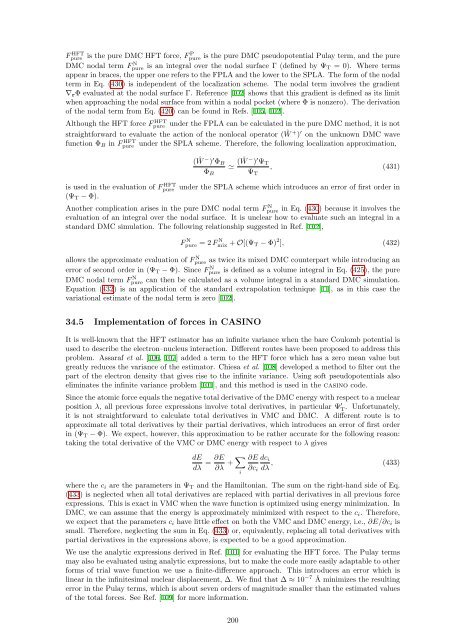CASINO manual - Theory of Condensed Matter
CASINO manual - Theory of Condensed Matter
CASINO manual - Theory of Condensed Matter
You also want an ePaper? Increase the reach of your titles
YUMPU automatically turns print PDFs into web optimized ePapers that Google loves.
Fpure<br />
HFT is the pure DMC HFT force, Fpure P is the pure DMC pseudopotential Pulay term, and the pure<br />
DMC nodal term Fpure N is an integral over the nodal surface Γ (defined by Ψ T = 0). Where terms<br />
appear in braces, the upper one refers to the FPLA and the lower to the SPLA. The form <strong>of</strong> the nodal<br />
term in Eq. (430) is independent <strong>of</strong> the localization scheme. The nodal term involves the gradient<br />
∇ r Φ evaluated at the nodal surface Γ. Reference [102] shows that this gradient is defined as its limit<br />
when approaching the nodal surface from within a nodal pocket (where Φ is nonzero). The derivation<br />
<strong>of</strong> the nodal term from Eq. (420) can be found in Refs. [105, 102].<br />
Although the HFT force Fpure<br />
HFT under the FPLA can be calculated in the pure DMC method, it is not<br />
straightforward to evaluate the action <strong>of</strong> the nonlocal operator (Ŵ + ) ′ on the unknown DMC wave<br />
function Φ B in Fpure<br />
HFT under the SPLA scheme. Therefore, the following localization approximation,<br />
(Ŵ − ) ′ Φ B<br />
Φ B<br />
≃ (Ŵ − ) ′ Ψ T<br />
Ψ T<br />
, (431)<br />
is used in the evaluation <strong>of</strong> Fpure<br />
HFT<br />
(Ψ T − Φ).<br />
under the SPLA scheme which introduces an error <strong>of</strong> first order in<br />
Another complication arises in the pure DMC nodal term F N pure in Eq. (430) because it involves the<br />
evaluation <strong>of</strong> an integral over the nodal surface. It is unclear how to evaluate such an integral in a<br />
standard DMC simulation. The following relationship suggested in Ref. [102],<br />
F N pure = 2 F N mix + O[(Ψ T − Φ) 2 ], (432)<br />
allows the approximate evaluation <strong>of</strong> F N pure as twice its mixed DMC counterpart while introducing an<br />
error <strong>of</strong> second order in (Ψ T − Φ). Since F N pure is defined as a volume integral in Eq. (425), the pure<br />
DMC nodal term F N pure can then be calculated as a volume integral in a standard DMC simulation.<br />
Equation (432) is an application <strong>of</strong> the standard extrapolation technique [11], as in this case the<br />
variational estimate <strong>of</strong> the nodal term is zero [102].<br />
34.5 Implementation <strong>of</strong> forces in <strong>CASINO</strong><br />
It is well-known that the HFT estimator has an infinite variance when the bare Coulomb potential is<br />
used to describe the electron–nucleus interaction. Different routes have been proposed to address this<br />
problem. Assaraf et al. [106, 107] added a term to the HFT force which has a zero mean value but<br />
greatly reduces the variance <strong>of</strong> the estimator. Chiesa et al. [108] developed a method to filter out the<br />
part <strong>of</strong> the electron density that gives rise to the infinite variance. Using s<strong>of</strong>t pseudopotentials also<br />
eliminates the infinite variance problem [101], and this method is used in the casino code.<br />
Since the atomic force equals the negative total derivative <strong>of</strong> the DMC energy with respect to a nuclear<br />
position λ, all previous force expressions involve total derivatives, in particular Ψ ′ T . Unfortunately,<br />
it is not straightforward to calculate total derivatives in VMC and DMC. A different route is to<br />
approximate all total derivatives by their partial derivatives, which introduces an error <strong>of</strong> first order<br />
in (Ψ T − Φ). We expect, however, this approximation to be rather accurate for the following reason:<br />
taking the total derivative <strong>of</strong> the VMC or DMC energy with respect to λ gives<br />
dE<br />
dλ = ∂E<br />
∂λ + ∑ i<br />
∂E<br />
∂c i<br />
dc i<br />
dλ , (433)<br />
where the c i are the parameters in Ψ T and the Hamiltonian. The sum on the right-hand side <strong>of</strong> Eq.<br />
(433) is neglected when all total derivatives are replaced with partial derivatives in all previous force<br />
expressions. This is exact in VMC when the wave function is optimized using energy minimization. In<br />
DMC, we can assume that the energy is approximately minimized with respect to the c i . Therefore,<br />
we expect that the parameters c i have little effect on both the VMC and DMC energy, i.e., ∂E/∂c i is<br />
small. Therefore, neglecting the sum in Eq. (433) or, equivalently, replacing all total derivatives with<br />
partial derivatives in the expressions above, is expected to be a good approximation.<br />
We use the analytic expressions derived in Ref. [101] for evaluating the HFT force. The Pulay terms<br />
may also be evaluated using analytic expressions, but to make the code more easily adaptable to other<br />
forms <strong>of</strong> trial wave function we use a finite-difference approach. This introduces an error which is<br />
linear in the infinitesimal nuclear displacement, ∆. We find that ∆ ≈ 10 −7 Å minimizes the resulting<br />
error in the Pulay terms, which is about seven orders <strong>of</strong> magnitude smaller than the estimated values<br />
<strong>of</strong> the total forces. See Ref. [109] for more information.<br />
200

















